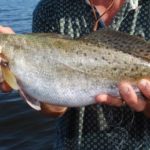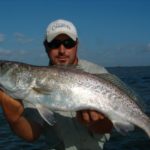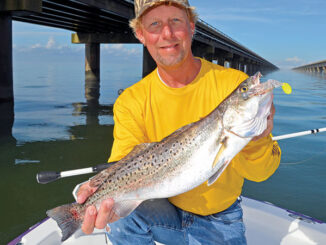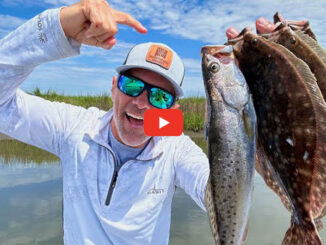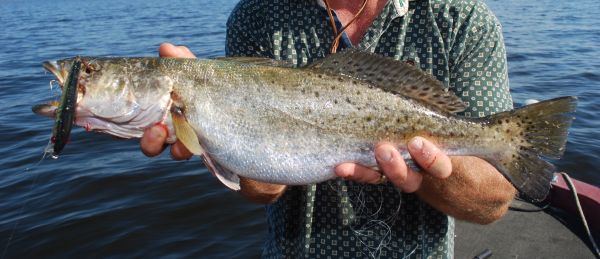
Putting to rest popular misconceptions
The popularity of speckled trout in Louisiana eclipses that of any other saltwater species, perhaps by several fold. We love to catch them, and we love to eat them. Twelve-inchers are great in the pan, and a 7-pound-plus mounted speck on the wall is a mark of angling success.
In their endless pursuit of more trout or bigger trout, anglers have analyzed and thought over every aspect of their quarry’s life cycle. In spite of the fact that so much of this well-researched species’ biology has been published, a lot of misinformation still floats around in speckled trout angling circles.
Some of it is hard to kill.
One incorrect observation that is stated over and over again is that speckled trout follow the migration of shrimp into the marsh in the spring. This is incorrect in two respects.
First, when 100-count shrimp first appear in coastal lakes and bays in April and May, they aren’t moving “in.” Actually, they are in the process of moving “out” from the shallow marshland nursery areas, first into lakes and bays, and then into the Gulf. These shrimp did indeed come in — several months earlier as fingernail-size post larvae. But they didn’t just come in from offshore.
Secondly, the trout aren’t moving “in” from offshore, either. They are simply changing from their wintertime pattern into their summer pattern of concentrating in the lower parts of high-salinity bays, passes and beaches where they will spawn.
During the winter, male speckled trout concentrate in numbers in interior low-salinity, sometimes almost freshwater, marshes. During the winter, females tend to be scattered widely throughout the ecosystem, with no concentration of numbers anywhere.
The summer speckled trout spawn produces more myths, to which some anglers stubbornly cling. One that I hear a lot is that speckled trout will pair up during spawning season, and that the male will fan out a “nest” for the female to lay her eggs in.
Most who ascribe to this theory place the nest in quiet waters behind barrier islands — places with little current to disturb the nest. Sometimes the nest is placed in coffee-ground-like detritus and sometimes it is in marsh grass stubble.
This actually does describe the way that a certain fish species spawns, but it is the largemouth bass, not speckled trout. Speck spawning is almost the exact opposite of the picture painted above.
In Louisiana, speckled trout almost always spawn in groups numbering in dozens to thousands in deep, moving water, such as passes between barrier islands or natural and manmade channels in open water. Water depth in these locations is usually between 10 and 100 feet deep. Current seems to be necessary to keep the eggs from sinking to the bottom and suffocating.
Spawning always takes place between 6 p.m. and midnight. Males typically gather at the site an hour or two before sunset. There, they begin drumming — vibrating their tough swim bladder with surrounding muscles. The grunts, knocks and raps made by hundreds of males at one time sounds like a constant roar.
Drumming hits its peak around 8 or 9 p.m. and decreases sharply after 11 p.m. It is assumed that drumming activity attracts females to the site.
During spawning, the trout in the school mill constantly, with light side-to-side contact between the fish. Eggs and sperm are discharged into the water for random fertilization. The outgoing current in the channel or pass rapidly sweeps the eggs out to Gulf waters, where they float untended until they hatch.
This brings me to the final myth — my favorite.
Many speckled trout anglers use small croakers as bait. They are fairly tough and live well in a livewell or on a hook. They are fairly easy to come by, and speckled trout really seem to like to eat them.
The oft-repeated theory as to why croakers are such good speck bait is that female trout “hate” them because croakers eat their eggs. This one is hard to discuss without bringing a smile to my face.
Speckled trout abandon their eggs to the sea immediately after spawning. A week later she does the same thing again. She does this repeatedly all summer. It is hard to picture a female trout following her eggs out to sea (in the dark no less) to check on their well-being, even if she could tell her eggs apart from all the other fish eggs in the sea.
A second problem with this theory is that fertilized speckled trout eggs are buoyant and float near the surface, and croakers are demersal creatures, meaning they live and feed near the bottom.
Thirdly, it is hard to attribute the emotion of hate to such a primitive creature as a speckled trout. Indeed, if they feel hate, they must also feel love — and being in love. Picture that.
Finally, male trout seem to like to eat croakers just as much as do females. Yet, one only hears that female trout hate their egg-eating croaker cousins.
